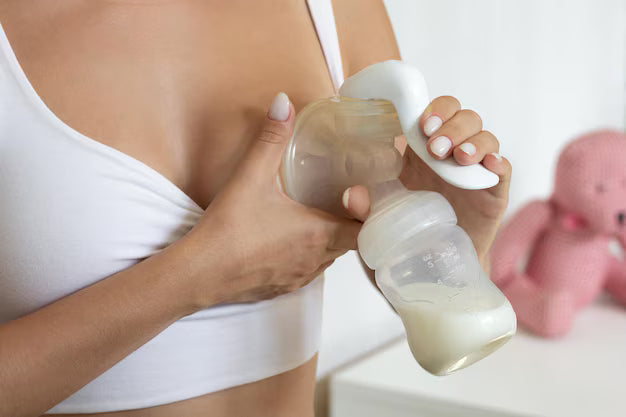
Frozen Breast Milk: A Complete Guide for Safe Storage, Thawing, and Feeding
Share
Breast milk is often called “liquid gold” because of its unmatched nutritional and immune-boosting properties for babies. However, busy schedules, returning to work, or health concerns may mean you can’t always breastfeed directly. That’s where frozen breast milk becomes a lifesaver. Freezing allows mothers to build a supply for future use while ensuring that babies continue to receive all the vital nutrients they need.
In this comprehensive guide, we’ll cover everything you need to know about storing frozen breast milk, thawing it safely, understanding the freezer milk shelf life, and ensuring that your baby gets the best quality milk even after storage.
Why Freeze Breast Milk?
Freezing breast milk provides flexibility for mothers and caregivers. Whether you’re pumping at work, preparing for a night out, or managing oversupply, frozen milk ensures your baby always has access to nutrition. The main benefits include:
-
Convenience – Have milk ready whenever your baby needs it.
-
Reduced waste – Oversupply can be stored instead of being discarded.
-
Peace of mind – Emergency supply in case you’re unavailable.
-
Nutrition security – Babies continue to get the benefits of breast milk even if direct feeding isn’t possible.
Learn more about breast milk vs formula here: Breast Milk vs Formula.
Storing Frozen Breast Milk
Proper storage ensures that your milk retains its nutrients and stays safe for your baby.
Best Practices for Storing Breast Milk in the Freezer
-
Use breast milk storage bags or BPA-free bottles – These are sterile, leak-proof, and specifically designed for safe storage.
-
Label clearly – Include the date and time the milk was expressed.
-
Portion control – Store milk in small amounts (2–4 ounces) to reduce waste.
-
Leave room in containers – Breast milk expands when frozen.
Ideal Frozen Milk Temperature
-
Store breast milk at 0°F (-18°C) or colder.
-
A deep freezer (-20°C) extends shelf life even further.
Freezer Milk Shelf Life
How long you can keep frozen milk depends on your storage method:
-
Standard freezer (inside fridge) – Up to 2 weeks.
-
Freezer with separate door – 3–6 months.
-
Deep freezer (-20°C) – 6–12 months (best within 6 months for quality).
Always use the oldest milk first (FIFO: First In, First Out).
Freezing Milk Safely
To freeze milk without compromising its quality:
-
Chill freshly pumped milk in the refrigerator before transferring it to the freezer.
-
Place milk at the back of the freezer, where the temperature remains consistent.
-
Avoid keeping milk in the freezer door since temperatures fluctuate.
Thawing Frozen Milk
Thawing correctly is just as important as storing correctly. Improper thawing can destroy nutrients or introduce bacteria.
How to Thaw Frozen Breast Milk
-
Refrigerator method (safest) – Move milk to the fridge and let it thaw overnight (takes about 12 hours).
-
Warm water method (faster) – Place the sealed milk bag or bottle in a bowl of warm water.
-
Bottle warmers – Convenient for quick and safe warming.
What NOT to Do
-
Never thaw or warm breast milk in the microwave – it creates hot spots and destroys nutrients.
-
Do not refreeze thawed milk.
Using Thawed Breast Milk
Once milk is thawed:
-
Keep it in the refrigerator and use it within 24 hours.
-
If milk is warmed, it should be used within 2 hours.
-
Gently swirl milk before feeding to mix in separated fat (don’t shake vigorously).
Signs Frozen Milk Has Gone Bad
Even with proper storage, frozen breast milk can spoil. Watch out for:
-
Sour or rancid smell.
-
Clumps or separation that doesn’t blend when swirled.
-
Sour taste (test with a clean spoon if unsure).
If in doubt, discard the milk.
Frozen Milk While Traveling
Traveling with frozen breast milk is possible with the right precautions:
-
Use insulated cooler bags with ice packs.
-
Keep milk as cold as possible until you can place it in a freezer.
-
For flights, check airline policies; most allow transport of breast milk in carry-on bags.
Tips for Maximizing Nutrition in Frozen Milk
-
Freeze milk in smaller batches: Storing milk in 2–4 oz portions makes thawing faster and prevents waste if your baby only drinks a little.
-
Store milk in flat layers: Laying storage bags flat before freezing saves freezer space and helps the milk thaw more evenly.
-
Combine milk carefully: Only mix milk pumped on the same day, and make sure both portions are cooled first to prevent bacterial growth.
-
Label clearly: Always write the date and time of pumping so you can use the oldest milk first.
-
Use freezer-safe containers: Choose breast milk bags or BPA-free bottles designed for freezing to maintain quality and prevent leaks.
Common Mistakes to Avoid
-
Freezing milk immediately after pumping: Always chill freshly expressed milk in the fridge before freezing to lock in nutrients and reduce bacterial risks.
-
Storing milk in the freezer door: The door is prone to temperature changes, which can spoil milk. Keep it in the back of the freezer instead.
-
Using glass bottles without leaving space: Frozen milk expands, so glass bottles may crack if not enough room is left at the top.
-
Refreezing thawed milk: Once thawed, milk loses quality and may develop harmful bacteria if frozen again—use it within 24 hours.
-
Not rotating stored milk: Forgetting to use the oldest milk first can lead to waste when bags expire at the back of the freezer.
Conclusion
Freezing breast milk is one of the best ways to ensure your baby always has access to nutritious feeding, no matter your circumstances. By following the right steps for storing frozen breast milk, maintaining the correct frozen milk temperature, and practising safe thawing frozen milk methods, you can protect both the nutrients and safety of your liquid gold.
Proper handling gives you peace of mind while ensuring your baby continues to thrive.
FAQs
What is the best way to store frozen breast milk?
Use breast milk storage bags or BPA-free bottles. Always label them with the date and store them in the back of the freezer, not in the door.
How long does frozen breast milk last?
It lasts 3–6 months in a regular freezer and up to 12 months in a deep freezer, though the best quality is within 6 months.
Can I refreeze breast milk after thawing?
No, once thawed, breast milk should never be refrozen as it increases the risk of bacterial growth.
How do I thaw frozen breast milk quickly?
You can thaw it in a bowl of warm water or use a bottle warmer. This takes a few minutes compared to thawing in the fridge overnight.
Is it safe to microwave breast milk?
No, microwaving destroys nutrients and creates hot spots that could burn your baby’s mouth.
What is the right temperature for storing frozen milk?
The freezer should be at 0°F (-18°C) or colder. A deep freezer at -20°C is ideal for longer storage.
Does freezing affect breast milk nutrients?
Some immune properties may decrease slightly, but frozen breast milk is still far superior to formula.
Can I mix freshly pumped milk with already frozen milk?
Yes, but only if the fresh milk has been chilled first. Never add warm milk directly to frozen milk.
What should I do if my baby refuses thawed milk?
Some babies notice a change in taste due to lipase activity. You can scald fresh milk before freezing to reduce this.
How do I travel with frozen breast milk?
Use an insulated cooler with ice packs. Keep milk as cold as possible until it can be transferred to a freezer.
